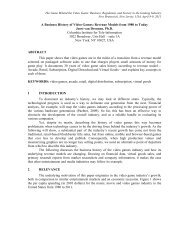Trading Card Game Industry White Paper - SuperData Research
Trading Card Game Industry White Paper - SuperData Research
Trading Card Game Industry White Paper - SuperData Research
Create successful ePaper yourself
Turn your PDF publications into a flip-book with our unique Google optimized e-Paper software.
Typically a player purchases a starter set, containing a manual and a playable deck of cards that<br />
showcases the rules and mechanics of the game in an introductory fashion. One of the biggest obstacles<br />
that faces any new TCG is the need for an opponent to truly engage in the game play as it is extremely<br />
unusual for any TCG to feature a solitaire mode. Players generally begin playing through a<br />
friend, at a particular location like a hobby game store that has a time and date for an organized gaming<br />
opportunity that includes a tutorial component, or via an online portal (which may feature online<br />
game play, but not necessarily).<br />
In general, TCGs are comprised of three basic components. First there are the rules of the game, a<br />
set of instructions governing every aspect of game play, from which player will go first, to how to determine<br />
which player wins, and everything in between. These are usually broken down into:<br />
A basic rule book contains the most basic set of rules. This is generally a booklet that<br />
comes with the starter materials and is aimed at beginning players. In many instances,<br />
like Chaotic, a play mat often accompanies the rule book, and serves to map out the<br />
placement of the game’s components during game play. Often the design of the play mat<br />
includes a quick breakdown or cheat sheet that lists the game’s main rules.<br />
Comprehensive rules serve as the backbone of every aspect of the game and are usually<br />
stored on the main website for the game. These rules require a degree of experience for a<br />
player to fully understand them.<br />
A document listing floor-rules. This is essentially a code of conduct for players, judges, and<br />
tournament officials once a game has developed an organized play program.<br />
Secondly, there are of course the cards themselves. These serve as the actual playing pieces, and<br />
contain text describing their unique characteristics. Without exception, TCGs feature an inventory of<br />
cards far greater in number than a player can play with in any one deck. Once a player graduates from<br />
the initial stage of learning a game using pre-built decks, s/he will build their own unique decks, consisting<br />
of a small subset of cards. <strong>Card</strong>s will usually fall into one of five categories:<br />
Creatures or characters are a staple of virtually every trading card game. Almost all TCGs<br />
feature some form of combat between characters either based on an existing licensed<br />
property (e.g. Buffy the Vampire Slayer) or drawing from popular genres such as fantasy.<br />
The cards are, in a sense, playing pieces with their rules inscribed on them.<br />
Creature enhancements are usually represented as weapons, vehicles, items, or armor,<br />
which the player can use to enhance a creature card.<br />
Events are cards that impact the flow of the game. These cards can range from simple<br />
effects, like drawing additional cards, to affecting a creature card on the<br />
board, to more sweeping and powerful effects. The easiest way to think of these cards is<br />
to think of the "Skip," "Draw Two," and "Reverse" cards in Uno.<br />
With resource cards a player generally buys the ability to put other cards into play. They<br />
are a form of in-game currency that forces a fixed budget on the player. Not all trading<br />
card games features such a resource system, but it is fairly common. Resource cards tend<br />
to be specific in what they afford the player. Colors generally indicate the range of abilities<br />
it buys.<br />
Location cards are not featured in all games but some games use them to represent a field<br />
of battle. Some games will further break down card types based on specific components of<br />
the brand's story line.<br />
Third, the intellectual property("IP") serves as the basic narrative universe on which the game<br />
builds. The story components generally influences the design, rule set and the cards themselves. Early<br />
games like Magic: The Gathering draws on its own, original IP, using fantasy tropes. But as more com-<br />
2






